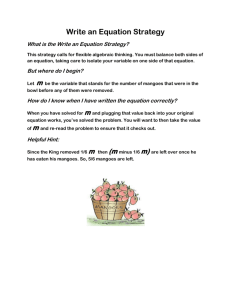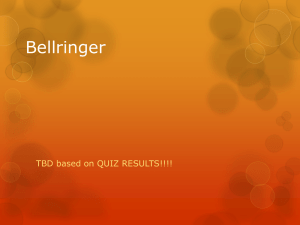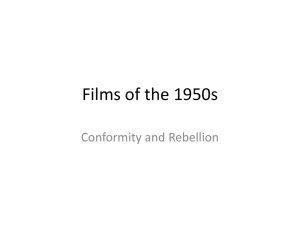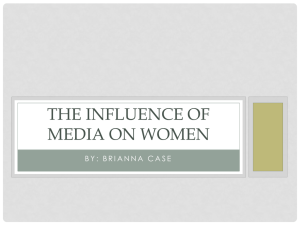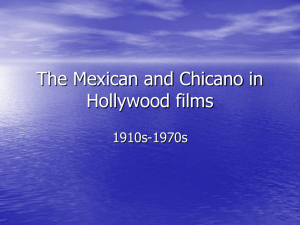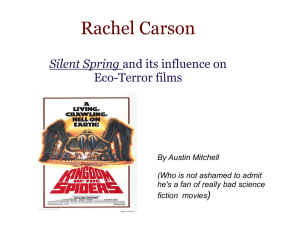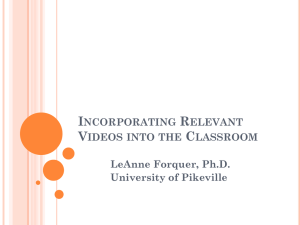NanoPackSafer
advertisement
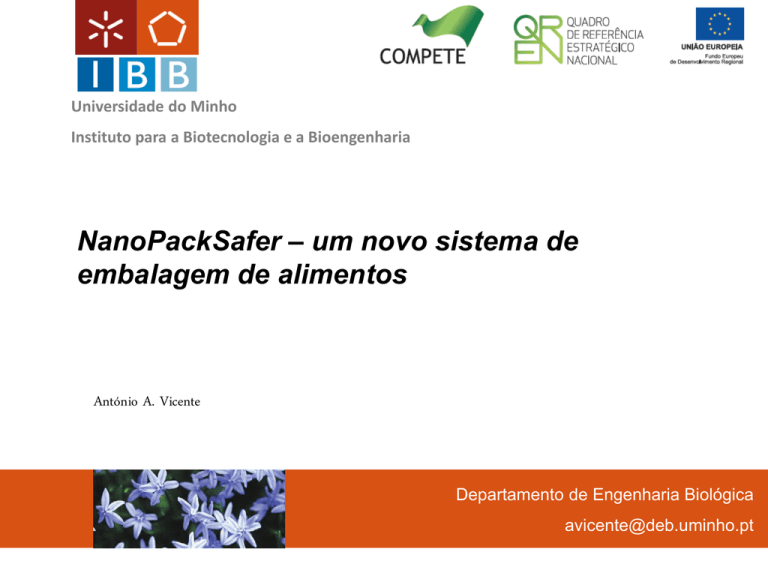
Universidade do Minho Instituto para a Biotecnologia e a Bioengenharia NanoPackSafer – um novo sistema de embalagem de alimentos António A. Vicente Departamento de Engenharia Biológica avicente@deb.uminho.pt NanoPackSafer OBJECTIVE: This proposal aims at developing nanotechnology-based food protection strategies by providing active packaging systems which will proactively act to maintain or even to increase food quality, safety and health impact of foods from production to consumption. Nanotechnology According to the European Commission’s Recommendation (EFSA): Nanomaterial means a material that meets at least one of the following criteria: • consists of particles, with one or more external dimensions in the size range 1 nm - 100 nm for more than 50 % of their number size distribution; • has internal or surface structures in one or more dimensions in the size range 1 nm – 100 nm; • has a specific surface area by volume greater than 60 m2/cm3, excluding materials consisting of particles with a size lower than 1 nm. Nanotechnology According to the US Food and Drug Administration (FDA): Nanomaterial: • If an engineered material or final product has at least one dimension at the nanometer scale (1 - 100 nanometers) • If an engineered material or final product shows properties or phenomena (including physical, chemical or biological effects) attributable to its dimensions, including if these lay out of the nanometer scale, up to the micrometer Functionality Motivation Consumers Environment All bio-materials from renewable sources All food-grade, edible materials Nano-sized systems Ethical aspects Nano-engineered films andcoatings coatings From Macro to Microfilms to Nano Nano-engineered and - Clay nanoparticles - Can you see me? Can you see me? Nano-engineeredfilms filmsand andcoatings coatings Nanotechnology Nano-engineered - Clayrevolution nanoparticles – the promise of a food Improved sensorial properties Healthier and more nutritious foods Better packaging systems Traceability and monitoring along food chain Materials at the nano scale have different properties Nano-engineered films and coatings - nanolaminates Nano-engineered films and coatings - nanolaminates A nanolaminate is a film or coating composed of two or more layers of material with nanometer dimension that are physically or chemically bonded to each other Need for successive layers of materials: • • • Better physical stability in aggressive environments Better chemical stability of the incorporated compounds Improved control of the release rates • Coexistence of possibly incompatible functionalities Advantages of being nano-sized: • • • Lesser amounts of ingredients needed Less impact in the sensory attributes of foods Different behaviour expected in terms of transport properties - Of gases - Of entrapped (functional) solutes Nano-engineered films and coatings - nanolaminates 10 Nano-engineered films and coatings - nanolaminates Alginate layers Chitosan layers 11 Nano-engineered films and coatings - nanolaminates Characterization of the nanolayered film Gas barrier properties Films 1 2 Thickness WVP x 1011 (g.m-1.s-1.Pa-1) (µm) Improved barrier O2P x 1014 Improved barrier (g.m.Pa-1.s-1.m-2) Aminolyzed PET 103.00 1.42 ± 0.39 --------- 2.50 ± 0.03 -------- PET + 5 layers 103.27 1.08 ± 0.10 --------- 2.12 ± 0.03 -------- 5 layers 0.27 0.019 ± 0.005 --------- 0.069 ± 0.006 -------- Pectin1 100-150 61.9 ± 5.6 14.2 % ------------ --------- Chitosan2 45-50 8.60 ± 0.14 38.9 % 7.12 ± 0.23 170 % Hoagland and Parris (1996). Journal of Agricultural and Food Chemistry, 44, 1915-1919 Fajardo et al. (2010). Journal of Food Engineering. Release from chitosan nanolayered films in liquid medium K-carrageenan/chitosan nanolayered film with a model compound (Methylene Blue) incorporated on the 2nd, 4th or 6th layer UV-VIS spectroscopy, 190-800 1.8 MB in second layer aminolyzed PET 1.6 nm MB in fourth layer 1.4 MB in sixth layer Absorbance 1.2 1 0.8 0.6 0.4 0.2 - - - - water ++ + + + 0 400 550 600 650 700 Wavelength (nm) Adsorption (ug/cm2) Positively Charged: 0.2 % chitosan, pH 3 or 0.3 % of Methylene Blue, pH 7 500 water Real time deposition Quartz Crystal Microbalance 30 Negatively Charged: 0.2 % k-carrageenan pH 7 450 25 20 MB in second layer 15 MB in fourth layer MB in sixth layer 10 5 0 0 500 1000 Time (s) 1500 Release from chitosan nanolayered films in liquid medium MB release from nano layered films Nanolayered films with MB in the: 2nd Layer 4th Layer 6th Layer Incubation of films in 0.01 M PBS pH 2 and 7 MB release evaluated by UV-VIS spectroscopy at 600 nm Release from chitosan nanolayered films in liquid medium MB release from nano layered films Nanolayered films with MB in the 6th Layer 1,2 1 Mt/M∞ 0,8 Experimental Eq. 1 Eq. 2 0,6 0,5 0,4 0 0,2 -15 -5 5 15 0 -20 60 140 220 time (min) 300 380 Fick´s transport Anomalous behaviour ok – Fick + 1 main reconfiguration Release from chitosan nanolayered films in liquid medium MB release from nano layered films Nanolayered films with MB in the 2nd and 4th Layers pH=7 pH=2 Fick´s transport Fick´s transport Anomalous behaviour Anomalous behaviour – Fick + 1 main reconfiguration + + + + + + ++ + + - -- - - - - - - - + + + + + + ++ + + - -- - - - - - - - Strong electrochemical interaction - affects the transport mechanism, which cannot be described by neither Fickian nor anomalous behaviour ok – Fick + 1 main reconfiguration + + + + + + ++ + + + + + + + + ++ + + + + + + + + ++ + + + + + + + + ++ + + “Normal” interaction -behaves as a “macro” polymeric network Applications Application on mangoes Contact angle Applications Application on mangoes – Shelf-life analysis Weight loss 4.5 Mangoes without nanolayers 4 Weight Loss(%) 3.5 Mangoes with nanolayers 3 2.5 2 1.5 1 0.5 0 0 7 14 21 28 35 42 49 Days The pectin/chitosan nanolayers reduced the weight loss of the mangoes. Applications on mangoes – Shelf-life analysis Application Soluble solids (SS) Titratable acidity (TA) 0.9 19 17 Mangoes without nanolayers 0.7 Mangoes with nanolayers 0.6 TA (%) 15 SS (%) 0.8 13 11 0.5 0.4 0.3 0.2 Mangoes without nanolayers 9 0.1 7 0 7 14 21 28 Days 35 42 49 0 0 7 14 21 28 35 42 Days Mangoes with nanolayers: Lower SS variation and lower redution of TA Delay in ripening 49 Applications Application Without coating With pectin/chitosan nanolayers on mangoes – Appearance after 45 days Applications Application on pears – Appearance after 7 days of refrigerated storage 21 Take-home messages Plenty of room for improvement of food nano-systems Need to improve detection/characterization methods Countless applications in foods Need to evaluate impact on health Need to evaluate impact on environment Ethical aspects? Thank you for your attention
